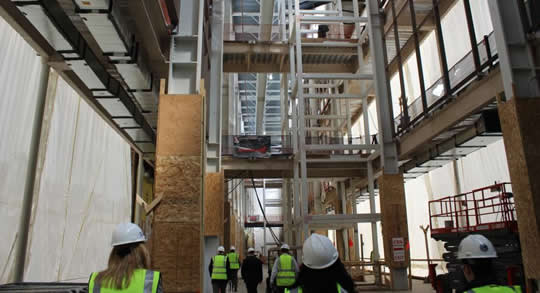By Sandra Basu
WASHINGTON—The long delayed and over-budget Rocky Mountain Regional Medical Center in Aurora, CO, is finally scheduled to open its doors in August 2018, but lawmakers are questioning why it lacks the primary care space needed and has the same number of beds as the hospital it is replacing.
“Even after the new medical center opens, VA must continue operating the old medical center, because presently some of the primary care doctors and the PTSD residential rehabilitation facility have nowhere else to go,” said House Committee on Veterans Affairs Chairman Phil Roe (R-TN).
The project has been the subject of many congressional hearings and GAO reports over the years as the originally requested design funds in FY 2004 of $328.5 million ballooned over the years to nearly 1.7 billion. The new facility is intended to replace the current Denver VA.

The Rocky Mountain Regional Medical Center in Aurora, CO, shown here in a construction photo, is finally scheduled to open its doors in August 2018, but lawmakers are questioning why it lacks the primary care space needed and has the same number of beds as the hospital it is replacing. Photo from Senate Committee on Veterans’ Affairs.
Calling it a “construction debacle,” Roe said the road to completing this hospital has “been extremely long and bumpy. This situation must never happen again.”
The view was expressed at a recent hearing where lawmakers and VA officials discussed features and activation plans for the new facility.
While Roe praised the facility’s new spinal cord injury treatment as state of the art, he pointed out the hospital has fewer psychiatric beds than the old hospital and lacks a PTSD residential facility. He also pointed out that the number of primary care rooms had been reduced from 60 to 34.
As a result, the old facility could have to stay open for as many as five years to accommodate the functions that won’t fit in the new hospital. “If it does stay open, there is an estimate that there would be $350 million dollars’ worth of work done to a campus that you are going to get rid of. None of this makes a lot of sense,” Roe pointed out.
Inadequate Space
VISN 19 VHA Network Director Ralph Gigliotti, FACHE, also acknowledged that the new facility did not have all the needed space and that seven Patient-Aligned Care Teams (PACT) will be left behind at the current facility, while the VA actively looks at accommodating them elsewhere. At the time of the original design of the hospital, PACTs were not used at VAMCs, officials said.
Rep. Mike Coffman (R-CO) said he only recently learned the new facility could not accommodate all of the PACTs.
“The VA hasn’t been transparent. In all the hearings we had the issue of keeping the old hospital open to house primary care outpatient services was never discussed or brought forward by the VA,” he said.
Meanwhile, lawmakers also expressed their frustration that a post-traumatic stress disorder (PTSD) residential facility was deleted from the hospital design due to the ballooning costs. Now, VA is seeking to build a new PTSD facility in the area.
“As an Iraq War veteran, how is it in 2009 and 2010 that we broke ground for a project without a PTSD [facility], without a plan for it?” Coffman questioned.
Stella Fiotes, acting principal executive director of the VA Office of Acquisition, Logistics and Construction, conceded that the hospital design “was probably more complex than it needed to be,” but emphasized it was designed a long time ago and that requirements have evolved since then.
“Going forward, we have learned much from this design that we would not replicate,” she said.
Fiotes told lawmakers that the VA has worked “diligently” to improve the management and oversight of its major construction program by partnering with the Army Corps and incorporating lessons learned so that “challenges that happened on this project will not happen again.” The new hospital had been turned over to the Army Corps of Engineers to finish after Congress mandated that VA outsource certain construction projects with costs greater than $100 million; that was in response to the delays and cost overruns associated with the facility.
“I’m here to tell you that VA today is doing business very differently than in the past. We are rethinking everything about how we will modernize our infrastructure to find ways to deliver much-needed facilities, smarter, faster and at significantly less cost,” she said.
When it comes to the activation of the new medical facility to prepare for the August opening, Fiotes said VA’s current activation budget for this project is $341 million, which covers activity from 2013 to 2020.
“The current activation schedule has the majority of installation, calibration and testing of newly procured equipment being completed in May 2018,” she explained. “This will enable the Denver Medical Center staff to complete over 40,000 staff hours of education, training, and orientation in July 2018.”
A 2017 Government Accountability Office (GAO) report questioned that estimate, pointing out that the most recent cost estimate of $341 million for activating, or bringing the Denver Medical Center into full operation, “had minimal supporting documentation.”
During the hearing Andrew Von Ah, team director for GAO Physical Infrastructure, said that while “VA has made improvements in its documentation of the estimates since [the] report,” that GAO “still cannot find that the current estimate meets the characteristics of a reliable estimate.”

